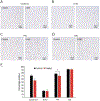PEGylated Polymeric Nanoparticles Loaded with 2-Methoxyestradiol for the Treatment of Uterine Leiomyoma in a Patient-Derived Xenograft Mouse Model
- PMID: 37482124
- PMCID: PMC10529399
- DOI: 10.1016/j.xphs.2023.07.018
PEGylated Polymeric Nanoparticles Loaded with 2-Methoxyestradiol for the Treatment of Uterine Leiomyoma in a Patient-Derived Xenograft Mouse Model
Abstract
Leiomyomas, the most common benign neoplasms of the female reproductive tract, currently have limited medical treatment options. Drugs targeting estrogen/progesterone signaling are used, but side effects and limited efficacy in many cases are major limitation of their clinical use. Previous studies from our laboratory and others demonstrated that 2-methoxyestradiol (2-ME) is promising treatment for uterine fibroids. However, its poor bioavailability and rapid degradation hinder its development for clinical use. The objective of this study is to evaluate the in vivo effect of biodegradable and biocompatible 2-ME-loaded polymeric nanoparticles in a patient-derived leiomyoma xenograft mouse model. PEGylated poly(lactide-co-glycolide) (PEG-PLGA) nanoparticles loaded with 2-ME were prepared by nanoprecipitation. Female 6-week age immunodeficient NOG (NOD/Shi-scid/IL-2Rγnull) mice were used. Estrogen-progesterone pellets were implanted subcutaneously. Five days later, patient-derived human fibroid tumors were xenografted bilaterally subcutaneously. Engrafted mice were treated with 2-ME-loaded or blank (control) PEGylated nanoparticles. Nanoparticles were injected intraperitoneally and after 28 days of treatment, tumor volume was measured by caliper following hair removal, and tumors were removed and weighed. Up to 99.1% encapsulation efficiency was achieved, and the in vitro release profile showed minimal burst release, thus confirming the high encapsulation efficiency. In vivo administration of the 2-ME-loaded nanoparticles led to 51% growth inhibition of xenografted tumors compared to controls (P < 0.01). Thus, 2-ME-loaded nanoparticles may represent a novel approach for the treatment of uterine fibroids.
Keywords: Bioavailability; Drug delivery system; Estrogen; Fibroid; Nanoparticles; Precision medicine.
Copyright © 2023 American Pharmacists Association. Published by Elsevier Inc. All rights reserved.
Conflict of interest statement
Declaration of Competing Interest The authors have no conflicts of interest to report.
Figures







Similar articles
-
Liposomal 2-Methoxyestradiol Nanoparticles for Treatment of Uterine Leiomyoma in a Patient-Derived Xenograft Mouse Model.Reprod Sci. 2021 Jan;28(1):271-277. doi: 10.1007/s43032-020-00248-w. Epub 2020 Jul 6. Reprod Sci. 2021. PMID: 32632769 Free PMC article.
-
Application of a Patient Derived Xenograft Model for Predicative Study of Uterine Fibroid Disease.PLoS One. 2015 Nov 20;10(11):e0142429. doi: 10.1371/journal.pone.0142429. eCollection 2015. PLoS One. 2015. PMID: 26588841 Free PMC article.
-
Establishment of a novel xenograft model for human uterine leiomyoma in immunodeficient mice.Tohoku J Exp Med. 2010 Sep;222(1):55-61. doi: 10.1620/tjem.222.55. Tohoku J Exp Med. 2010. PMID: 20814179
-
Epidemiological and genetic clues for molecular mechanisms involved in uterine leiomyoma development and growth.Hum Reprod Update. 2015 Sep-Oct;21(5):593-615. doi: 10.1093/humupd/dmv030. Epub 2015 Jul 3. Hum Reprod Update. 2015. PMID: 26141720 Free PMC article. Review.
-
[Selective progesterone receptor modulator (ulipristal acetate--a new option in the pharmacological treatment of uterine fibroids in women].Ginekol Pol. 2013 Mar;84(3):219-22. doi: 10.17772/gp/1567. Ginekol Pol. 2013. PMID: 23700851 Review. Polish.
Cited by
-
Synergistic inhibition of progesterone receptor-A/B signalling by simvastatin and mifepristone in human uterine leiomyomas.Clin Transl Med. 2024 Apr;14(4):e1672. doi: 10.1002/ctm2.1672. Clin Transl Med. 2024. PMID: 38649749 Free PMC article. No abstract available.
-
The utilization of nanotechnology in the female reproductive system and related disorders.Heliyon. 2024 Feb 1;10(3):e25477. doi: 10.1016/j.heliyon.2024.e25477. eCollection 2024 Feb 15. Heliyon. 2024. PMID: 38333849 Free PMC article. Review.
-
The Role of Nanomedicine in Benign Gynecologic Disorders.Molecules. 2024 May 1;29(9):2095. doi: 10.3390/molecules29092095. Molecules. 2024. PMID: 38731586 Free PMC article. Review.
-
Obesity Contributes to Transformation of Myometrial Stem-Cell Niche to Leiomyoma via Inducing Oxidative Stress, DNA Damage, Proliferation, and Extracellular Matrix Deposition.Genes (Basel). 2023 Aug 15;14(8):1625. doi: 10.3390/genes14081625. Genes (Basel). 2023. PMID: 37628676 Free PMC article.
-
Rethinking the application of nanoparticles in women's reproductive health and assisted reproduction.Nanomedicine (Lond). 2024;19(14):1231-1251. doi: 10.2217/nnm-2023-0346. Epub 2024 May 21. Nanomedicine (Lond). 2024. PMID: 38686941 Free PMC article. Review.
References
-
- Hurst BS, “Uterine Fibroids,” Ultrasound Imaging in Reproductive Medicine, pp. 137–153, 2019, doi: 10.1007/978-3-030-16699-1_9. - DOI
-
- Bulun SE, “Uterine Fibroids,” https://doi.org/10.1056/NEJMra1209993, vol. 369, no. 14, pp. 1344–1355, Oct. 2013, doi: 10.1056/NEJMRA1209993. - DOI - PubMed
Publication types
MeSH terms
Substances
Grants and funding
LinkOut - more resources
Full Text Sources

